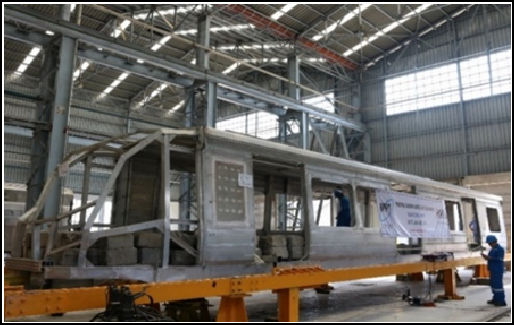Main Article Content
Abstract
In 2015, the Indonesian government issued regulations to accelerate the implementation of integrated Light-Rail Transit (LRT) in the capital region and its surroundings. In order to ensure its operational safety, experimental work is required to test components’ strength of the manufactured LRT structures. Following the JIS 7105 standard test method, the strain and deflection of the structures were measured by vertical load, compression, rotation, and three-point load support test. The critical area estimated in the railroad structure were conducted according to the finite element method, in which strain gauges are installed in areas where the stress concentration exceeds nominal pressure, namely notches, bends, and junction areas. The result shows that the maximum stress on the LRT train structure occurs at the door, where maximum compressive strain value is -1082 μe » -75.74 MPa on the left and the maximum tensile strain value is 597 μe » 41.79 MPa at the right door. The results of fatigue load analysis represent the average stress (σm) and voltage amplitude (σa) at the coordinate system located in the Søderberg triangle. Meanwhile, the camber value with the full vertical load still has a positive value of 3.03 mm, which indicates a safe limit.
Keywords
Article Details

This work is licensed under a Creative Commons Attribution-NonCommercial 4.0 International License.
References
- H. M. Taki, M. M. H. Maatouk, E. M. Qurnfulah, and M. O. Aljoufie, “Planning TOD with land use and transport integration: a review,” Journal of Geoscience, Engineering, Environment, and Technology, vol. 2, no. 1, p. 84, 2017.
- P. Chorus and L. Bertolini, “Developing transit-oriented corridors: Insights from Tokyo,” International Journal of Sustainable Transportation, vol. 10, no. 2, pp. 86–95, 2016.
- J. Calimente, “Rail integrated communities in Tokyo,” Journal of Transport and Land Use, vol. 5, no. 1, pp. 19–32, 2012.
- JTPA, “Japan’s Light-Rail Transit,” 2012. [Online]. Available: http://www.jtpa.or.jp/eng/contents/pdf/3_LRT2.pdf.
- T. Weng, “Analyzing Benefits of Urban Development and City Tourism with Light Rail Transit in Kaohsiung,” IOSR Journal of Business and Management (IOSR-JBM), vol. 18, no. 11, pp. 64–71, 2016.
- C. D. Higgins, M. R. Ferguson, and P. S. Kanaroglou, “Light rail and land use change: Rail transit’s role in reshaping and revitalizing cities,” Journal of Public Transportation, vol. 17, no. 2, pp. 93–112, 2014.
- H. Z. Rahman, P. Miraj, and A. Andreas, “Exploring public-private partnership scheme in operation and maintenance stage of Railway Project,” Sustainability (Switzerland), vol. 11, no. 22, 2019.
- F. Ferbrache and R. D. Knowles, “City boosterism and place-making with light rail transit: A critical review of light rail impacts on city image and quality,” Geoforum, vol. 80, pp. 103–113, 2017.
- M. F. Dziauddin, “Estimating land value uplift around light rail transit stations in Greater Kuala Lumpur: An empirical study based on geographically weighted regression (GWR),” Research in Transportation Economics, vol. 74, no. October 2018, pp. 10–20, 2019.
- A. C. Nelson, P. Stoker, and R. Hibberd, “Light rail transit and economic recovery: A case of resilience or transformation?,” Research in Transportation Economics, vol. 74, no. February 2018, pp. 2–9, 2019.
- E. S. Park and I. N. Sener, “Traffic-related air emissions in Houston: Effects of light-rail transit,” Science of the Total Environment, vol. 651, pp. 154–161, 2019.
- Valley Metro, “Design Criteria Manual,” Phoenix metropolitan area, 2018.
- ETS, “City of Edmonton - LRT Design Guidelines,” Edmonton, 2017.
- Nedal, “ALLOY DATA SHEET EN-AW 6005A [AlSiMg(A)] (Type:Medium strength extrusion alloy),” Nedal Aluminium, 2018. [Online]. Available: https://www.nedal.com/wp-content/uploads/2019/07/NEDAL_Datasheet-6005A.pdf. [Accessed: 01-Dec-2020].
- Aalco Metals Limited, “Aluminium Alloy - Commercial Alloy - 6005A - T6 Extrusion,” 2018. [Online]. Available: http://www.aalco.co.uk/datasheets/Aluminium-Alloy-6005A-T6-Extrusion_157.ashx. [Accessed: 01-Dec-2020].
- JIS, “JIS E 7105:2006 Rolling stock-Test methods of static load for body structures.” Japanese Standards Association, Tokyo, 2006.
- ASTM, “ASTM E8 Standard Test Methods for Tension Testing of Metallic Materials.” ASTM International, Conshohocken, 2013.
- American Welding Society, Structural Welding Code-Aluminium. New York: American National Standard Institute, 2014.
- J. W. Dally and W. F. Riley, Experimental Stress Analysis. New York: Mcgraw-Hill College, 1991.
- C. Wang, C. Wang, C. Liu, and Y. Jiang, “Research on Fatigue Test Method of Car Body for High-speed trains,” IOP Conference Series: Earth and Environmental Science, vol. 189, no. 6, 2018.
- JIS, “JIS E 7106:2006 Rolling stock—General requirements of carbody structures for passenger car.” Japanese Standards Association, Tokyo, 2006.
- MakeItFrom.com, “6005A-T6 Aluminum,” 2019. [Online]. Available: https://www.makeitfrom.com/material-properties/6005A-T6-Aluminum. [Accessed: 01-Dec-2020].
- J. Bannantine, Fundamentals of Metal Fatigue Analysis. New Jersey: Prentice Hall, 1990

